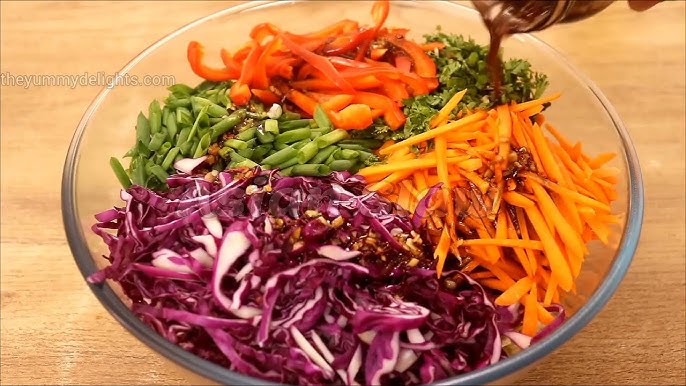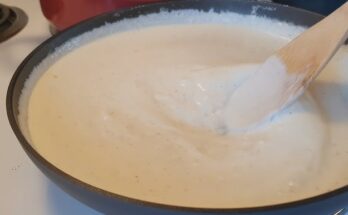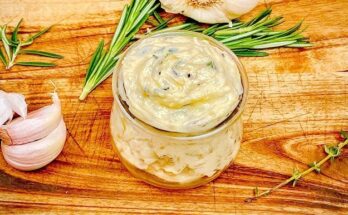Asian Slaw Dressing Recipe: Looking to level up your salads and slaws with a burst of flavor? This Asian slaw dressing recipe is going to be your new go-to. It’s zesty, a little sweet, slightly spicy, and full of umami goodness. Perfect for cabbage slaw, noodle bowls, or even as a marinade for chicken or tofu, this dressing comes together in minutes and packs a ton of flavor.
Whether you’re planning a summer BBQ, meal prepping lunches, or just trying to eat more veggies, this dressing is the flavor bomb you didn’t know you needed. Let’s walk you through exactly how to make it from scratch — no store-bought shortcuts here.
Why You’ll Love This Dressing
This isn’t your basic vinaigrette. It’s a fusion of bold flavors that hit all the right notes: tangy, sweet, salty, and spicy. What makes this dressing such a hit?
- It’s quick – just 5 minutes to whip up.
- Incredibly versatile – great for slaws, salads, dipping, and marinades.
- No fancy ingredients – everything can be found at your local grocery store.
- Customizable – make it sweeter, spicier, nuttier… your call.
Think of it as the secret weapon that turns boring raw cabbage into a crunchy, flavor-packed masterpiece.
What Is Asian Slaw Dressing?
Asian slaw dressing is a flavorful blend inspired by ingredients commonly found in East and Southeast Asian cuisines. It’s usually a combination of soy sauce, rice vinegar, sesame oil, and something sweet like honey or sugar. The beauty of this dressing is that it brings balance — no one flavor dominates. It works like a charm with shredded cabbage, carrots, scallions, and cilantro.
It’s not necessarily “traditional” to any one Asian culture, but rather a fusion-style creation that takes cues from Japanese, Thai, Chinese, and Korean flavor profiles. Some versions are light and vinegary, while others are creamy or spicy. We’ll show you how to build the flavor exactly how you like it.
List of Ingredients You’ll Need
Before diving into the step-by-step guide, let’s break down what you’ll need for this dressing.
Pantry Ingredients
- Soy sauce – The salty umami base. Use low-sodium if preferred.
- Rice vinegar – Gives the dressing its tang.
- Sesame oil – Toasted sesame oil adds a nutty depth.
- Honey or maple syrup – A touch of sweetness to balance the acidity.
- Olive oil or neutral oil – For a smoother consistency.
- Garlic (minced or grated) – Adds pungency and flavor.
- Ginger (fresh or paste) – Bright, spicy, and warming.
- Chili flakes or sriracha – Optional, for heat.
Fresh Ingredients
- Lime juice (optional) – Adds extra brightness.
- Scallions – Thinly sliced for garnish or blended into the dressing.
- Cilantro – Optional, but great for herby notes.
Optional Add-Ins for Extra Flavor
- Peanut butter – Makes it creamy and nutty.
- Fish sauce – Adds another level of umami (just a splash!).
- Miso paste – For a fermented umami punch.
- Tahini – If you’re avoiding peanuts but want creaminess.
Essential Equipment You’ll Need
- Mixing bowl
- Whisk or fork
- Measuring spoons
- Garlic press (optional)
- Small jar or container (for storing)
You don’t need a blender for this one (unless you’re adding things like peanut butter or miso), which makes cleanup super easy.
The Secret to a Perfect Slaw Dressing
Here’s the truth: the balance is everything. You’re aiming to hit five core flavor notes:
- Salty – soy sauce, miso
- Sour – rice vinegar, lime juice
- Sweet – honey or sugar
- Umami – garlic, ginger, sesame oil
- Spicy – chili flakes or sriracha
When these elements are in harmony, your dressing becomes magical. Always taste as you go, and adjust depending on your preferences or what you’re pairing it with.
Step-by-Step Guide to Making Asian Slaw Dressing
Now, let’s walk through making this dressing step-by-step.
Step 1: Prep All Ingredients
Gather your essentials — soy sauce, rice vinegar, sesame oil, honey (or sugar), minced garlic, and grated ginger. You can also add lime juice or chili flakes for extra zest and heat.
Step 2: Whisk the Base
In a medium bowl, combine soy sauce and rice vinegar as your liquid foundation. These two create the perfect salty-tangy balance typical of Asian flavors.
Step 3: Balance the Sweet and Tangy Flavors
Add honey or sugar to the mix, whisking until dissolved. This sweetness smooths out the sharp acidity and enhances overall depth.
Step 4: Emulsify for a Creamier Texture
Slowly drizzle in sesame oil while whisking continuously. This emulsifies the dressing, giving it a smooth, glossy consistency.
Step 5: Taste and Adjust
Sample your dressing and tweak to preference — add more vinegar for tang, honey for sweetness, or chili flakes for spice. Pour over slaw and toss before serving for a fresh, flavorful crunch.
How to Store Your Dressing Properly
So you’ve just made a killer batch of Asian slaw dressing — now what? Proper storage is crucial if you want to keep that fresh, bold flavor intact for more than just one meal.
Here’s what to do:
- Use a glass jar with a tight-fitting lid. Glass keeps the flavor pure and prevents any funky odors from seeping in (like those from your fridge).
- Label the jar with the date you made it. Homemade dressings don’t have preservatives like store-bought ones, so tracking freshness matters.
- Give it a shake before using. Natural separation will happen. Just shake it up for 10–15 seconds and you’re good to go.
Storing your dressing right helps you stretch it across several meals. It’s the little things that make a big difference.
How Long Does It Last in the Fridge?
Great news: This dressing lasts up to 7–10 days in the refrigerator when stored properly.
A few things to keep in mind:
- Fresh garlic and ginger can slightly reduce shelf life — they tend to intensify in flavor over time.
- If you used peanut butter or miso, the dressing may thicken when chilled. Just let it sit at room temperature for a few minutes or stir in a bit of warm water before using.
- Always do the sniff test before using. If anything smells off, toss it.
This shelf life makes it perfect for weekly meal prep or prepping ahead for gatherings.
Can You Freeze Asian Slaw Dressing?
Technically? Yes. Should you? Not really. Here’s why:
- Dressings with vinegar and oil can separate when frozen and become grainy or watery once thawed.
- If you added ingredients like peanut butter, miso, or fresh herbs, freezing will likely alter the texture and flavor — not in a good way.
If you’re in a pinch and want to freeze it anyway:
- Use ice cube trays to portion the dressing.
- Freeze and then store cubes in a sealed freezer bag for up to 1 month.
- Thaw in the fridge overnight and shake well before using.
But truth be told, it’s better to make it fresh or just refrigerate for weekly use.
Serving Suggestions
Asian slaw dressing isn’t just for cabbage slaw — it’s shockingly versatile. Here’s how you can use it to amp up flavor in multiple dishes.
Classic Slaw Combo
Toss it with:
- Shredded green and purple cabbage
- Julienned carrots
- Sliced green onions
- Chopped cilantro
- Crushed peanuts or sesame seeds on top
This makes a vibrant, crunchy slaw that pairs well with grilled chicken, pulled pork, or fish tacos.
As a Marinade
You can use this dressing to marinate:
- Chicken thighs or breasts
- Tofu cubes
- Shrimp
- Flank steak
Just let your protein soak for 30 minutes to an hour, then grill, bake, or pan-fry as usual. The acid in the vinegar helps tenderize, while the ginger and garlic add punch.
As a Salad Drizzle
Skip the boring ranch or Caesar. Use this dressing on:
- Kale and quinoa salads
- Mixed greens with edamame and crispy noodles
- Cold soba noodles and vegetables
Pro tip: Add toasted sesame seeds or crushed peanuts for extra crunch.
Customization Tips
Want to tweak this dressing to fit your exact taste buds? Easy. Here’s how to play around with the flavor without messing up the balance.
Make It Spicy
Add one or more of the following:
- 1 tsp Sriracha – a clean heat with garlicky undertones
- Chili oil – spicy, smoky, and fragrant
- Red pepper flakes – simple and effective
- Fresh Thai chili (minced) – if you’re brave
Just remember to add spice slowly — you can always add more, but you can’t take it out.
Make It Creamy
Want a thicker, richer texture?
- Add 1–2 tbsp peanut butter, tahini, or almond butter
- Stir in 1 tbsp mayonnaise or plain Greek yogurt for a creamier, tangy texture
This version sticks to the slaw a bit more, making it feel hearty and indulgent.
Make It Nutty
To really highlight the nutty flavor:
- Double the toasted sesame oil
- Add crushed roasted peanuts directly into the dressing
- Sprinkle sesame seeds on your final dish
This version pairs beautifully with cold noodle salads or Asian chicken wraps.
Common Mistakes to Avoid
Even though this dressing is simple, there are a few easy pitfalls to watch out for.
- Using too much sesame oil – A little goes a long way. Too much, and your dressing becomes overpowering.
- Skipping the sweetener – Sweetness balances the salt and vinegar. Don’t skip it.
- Not whisking enough – You want the oil and vinegar to emulsify. A quick mix won’t cut it.
- Overpowering with garlic – Garlic gets stronger as it sits. Don’t overdo it unless you’re a diehard garlic fan.
- Forgetting to taste and adjust – Everyone’s palate is different. Always tweak to your liking.
Avoid these, and you’ll be golden.
Nutrition Breakdown
Here’s a rough estimate of the nutritional profile for 2 tablespoons of this dressing:
| Nutrient | Amount |
|---|---|
| Calories | 100–120 |
| Total Fat | 9–11g |
| Saturated Fat | 1g |
| Carbohydrates | 4–6g |
| Sugar | 3–5g |
| Protein | 1g |
| Sodium | 300–400mg |
Note: These numbers vary depending on what ingredients and ratios you use, especially if you opt for low-sodium soy sauce or swap sweeteners.
FAQs about Asian Slaw Dressing Recipe
1. Can I make this dressing ahead of time?
Yes! It actually tastes better after a few hours in the fridge as the flavors meld together.
2. Is this dressing vegan?
It can be. Just use maple syrup instead of honey and skip fish sauce.
3. Can I make it gluten-free?
Absolutely. Use tamari or coconut aminos instead of soy sauce.
4. What’s the best oil to use?
Toasted sesame oil is key for flavor, but use a neutral oil like canola, avocado, or light olive oil to mellow it out.
5. What type of vinegar works best?
Rice vinegar is traditional and gives the best mild tang, but in a pinch, apple cider vinegar or white wine vinegar can work too.
Final Thoughts
This Asian slaw dressing is one of those kitchen staples that brings everything together. It’s the perfect balance of salty, sweet, sour, and umami. It makes raw veggies exciting, adds kick to proteins, and keeps your meals feeling fresh and flavorful without a ton of effort.
Whether you’re tossing it with crunchy cabbage, using it to dress up a soba noodle salad, or marinating your favorite protein — it just works.
So next time you’re bored with your usual salad routine, remember: a great dressing makes all the difference. And this one? It’s a game-changer.



